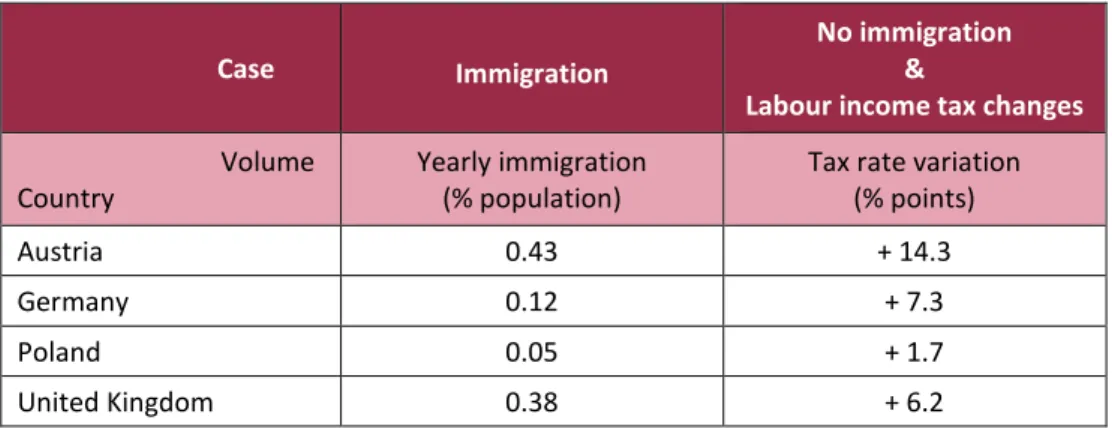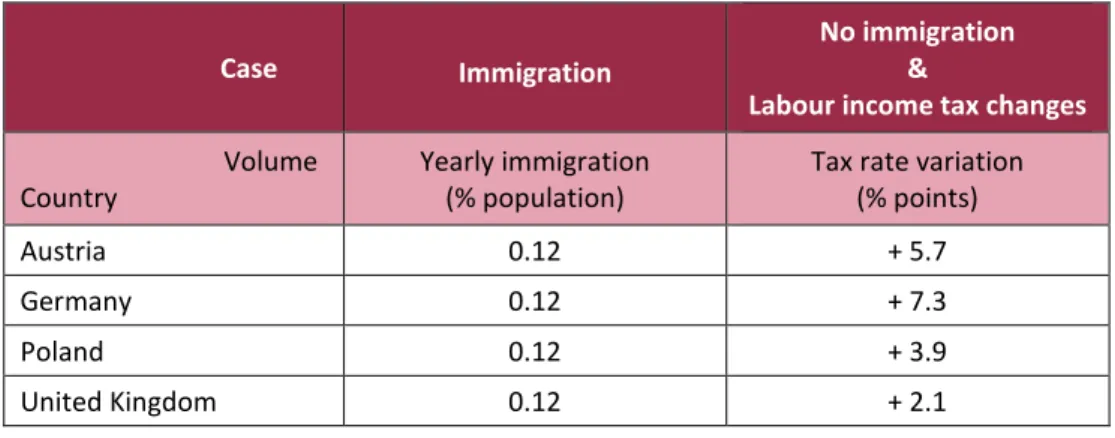Nr. 13, May 2016
The public finance contribution of immigration to Austria, Germany, Po- land and the United Kingdom over the long run
Thomas Davoine
Institute for Advanced Studies (Vienna)
Contact: davoine@ihs.ac.at / +43 1 59 99 12 43 / Josefstädter Strasse 39, 1080 Vienna, Austria
Executive Summary
Low fertility and increasing longevity change the age pyramid, putting pressure on the long-run financ- ing of pensions, healthcare and long-term care. If the retirement age remained constant in Europe, we would move from 4 workers supporting 1 retiree today to 4 workers supporting 2 retirees in 2060.
Because immigrants are on average younger than natives, immigration increases the ratio of workers to retirees and helps to solve the long-term financing challenge of social security. The recent study „Cross- country differences in the contribution of future migration to old-age financing“ (Berger et al., 2016) quantifies the public finance benefit of immigration in four EU countries, taking the specifics of the so- cial security system in each country into account as well as differences in education, unemployment and income between immigrants and native workers, but not the recent surge in asylum-seeking refugees.
Integration of immigrants into society is a process which requires efforts. Assuming that no cultural backlash takes place during the integration process, the study finds that immigration, as projected by Eurostat in 2010, helps the long run financing of pensions, healthcare and long-term care. Without im- migration labour taxes would have to be raised 14.3% points in 2060 in Austria, 7.3 in Germany, 6.2 in the UK and 1.7 in Poland to avoid additional deficits.
Part of the difference comes from projected immigration volumes, unequal across countries. Assuming the same migration volumes (relative to country size) in all countries, an end to immigration would re- quire a labour tax increase of 7.3% points in Germany, 5.7 in Austria, 3.9 in Poland and 2.1 in the UK to be in the same public finance position. Remaining differences come from institutions as well as age and education characteristics of domestic and migrant populations.
One should thus keep in mind that changes in immigration policy call for changes in social security poli-
cy. Immigration alone however does not resolve the financing challenge. Among many other factors,
differences in the long-run public finance contribution of immigration may also explain differences in
immigration policy stances across Europe, which the 2015-2016 refugee crisis has clearly revealed.
2
Long-run financing of old-age social security with an ageing population, a challenge
Old-age social security – public pensions, healthcare and long-term care – accounts for a large share of the public budget in developed economies. The average reaches 20% of GDP in the European Union.
Population ageing is a challenge for the long-run financing of old-age social security expenditures. Low fertility rates and increasing longevity indeed change the age structure of the population. Currently, about 4 workers support 1 retiree in the European Union. If the retirement age remained constant, this ratio would change to 4 workers supporting 2 retirees in 2060.
The European Union expects that the cost of old-age social security will increase 2% points of GDP by 2060. For some countries, the challenge is even bigger. For instance, the increase is close to 5% points of GDP in Germany (Ageing Working Group, 2015).
Reforms to address the challenge and the role of immigration
To address the challenge, governments have reformed social security over the years, focusing on pen- sions. Reforms have however differed across countries. Pension costs are still predicted to increase 2.7%
points of GDP in Germany, for example. Besides pensions, the financing of healthcare and long-term care remains challenging. Although recent policy reforms across the European Union have reduced the magnitude of the challenge, it is not fully addressed.
Immigration can help. Immigrants indeed take economic opportunities into account when choosing their destinations. They are younger in average than the European domestic population. Because of the age differential and the contribution of immigrants to economic activity, continuous immigration inflows increase the ratio of workers to retirees, which can ease the financing challenge of old-age social securi- ty over the long run (Storesletten, 2000).
Does immigration reduce the challenge everywhere, to the same extent?
Immigrants are younger than the domestic population in all European countries, but more in some countries (for instance, the United Kingdom) than others (for instance, Poland). Similarly, the share of older households is everywhere predicted to increase, but more in some countries (for instance, Ger- many) than others (for instance, the United Kingdom). Immigrants are also more likely to be unem- ployed in some countries (for instance, Austria) but not all (for instance, Poland). Finally, old-age social security systems and their costs also differ across countries.
These observations raise two questions:
1. Would immigration contribute to the long-run financing of old-age social security in all EU countries?
2. If yes, would the public finance contribution be identical in all countries if migration volumes were the same?
The recent Berger et al. (2016) study provides answers for four European Union countries, taking differ-
ences in age, education, unemployment and wages (for the same education level) between domestic
and immigrant populations into account. Additional tax revenues as well as public expenditures due to
immigration are included. Integration of immigrants into society is a process which requires efforts. To
avoid either pessimism or optimism, the study assumes that the integration of immigrants into society
and the labour market neither deteriorates (cultural backlash) nor improves over time. In particular,
wage and unemployment probability differences between natives and immigrants (for the same educa-
tion level), currently observed, are assumed to remain constant over time. To illustrate, the unemploy-
ment rate was 3.9% points higher for immigrants than natives in Germany in 2010 and 3.2% points low-
3
er in Poland. Ceteris paribus, these differences are kept constant over time. Finally and importantly, recent flows of asylum-seeking refugees, which have a temporary nature, are not taken into account.
Yes, but not to the same extent
Table 1 provides an answer to the first question for Austria, Germany, Poland and the United Kingdom.
Two cases are compared for each country. In the first case, immigration takes place as projected by Eurostat in 2010. In the second case, there is no immigration at all after 2016 and labour income taxes are changed so that the country has the same public debt as in the first case
1.
The answer to the first question is thus positive for Austria, Germany, Poland and the United Kingdom: if immigration was stopped after 2016, labour income tax rates would have to be increased to avoid an increase of the public debt; with immigration, the tax rate can be set lower. Immigration helps because immigrants are younger so the continuous inflow of immigration projected by the Eurostat prevents the workers-to-retirees ratio to decline much, counteracting the population ageing effect. Without immigra- tion, the workers-to-retirees ratio is lower, national labour income is lower; higher tax rates are then needed to avoid an increase in public debt.
Case Immigration
No immigration
&
Labour income tax changes Volume
Country
Yearly immigration (% population)
Tax rate variation (% points)
Austria 0.43 + 14.3
Germany 0.12 + 7.3
Poland 0.05 + 1.7
United Kingdom 0.38 + 6.2
Source: Eurostat (2010); Berger et al. (2016)
Table 1: Two cases for identical public debt in 2060, Eurostat migration projections
To answer the second question, comparable volumes of immigration need to be used across countries.
Table 2 does it. Two cases are again compared for each country. In the first case immigration again takes place, but migration volumes do not come from the Eurostat projections, as in table 1. Rather, they come from a hypothetical projection with identical future migration volumes in all countries, relative to the population size
2. In the second case, there is again no immigration and labour income taxes are changed so that the level of public debt is identical to the first case.
The answer to the second question is thus negative: in comparable terms, the public finance contribu- tion of immigration is not of the same magnitude in all countries. With identical migration volumes (rel- ative to population size), tax rates would need to be increased most in Germany (+7.3 % points) and least in the United Kingdom (+2.1 % points). Austria (+5.7 % points) and Poland (+3.9% points) would lie in the middle.
1 Instead of labour income tax variations, other changes could be considered to reach the same public debt level.
The study Berger et al. (2016) considers two other changes (pension benefit variations and retirement age varia- tions).
2 Specifically, all relative volumes equal the volumes for Germany projected by Eurostat.
4
Why the immigration contribution differs across countries depends mostly on the design of social securi- ty systems, as well as the age and education characteristics of the population. The UK public pension system indeed focuses on fighting poverty while the German system focuses on maintaining income after retirement. In the United Kingdom, public pension payments for high earners are relatively low compared to their wages, but not in Germany. This makes the UK pension system relatively cheap.
Stopping immigration would thus have a less dramatic impact in the United Kingdom. While the Austrian and German pension systems both focus on maintaining income, the German population has a lower workers-to-retiree ratio than the Austrian population. Immigration helps maintain the workers-to- retiree ratio most in Germany, and thus has largest public finance contribution. Outcomes for Poland depend both on age and education characteristics. On the one hand, the age difference between immi- grants and Polish natives is small, which reduces the public finance benefit of immigration. On the other hand, immigrants are in average more educated and taxes are progressive, which increases the public finance benefit of immigration. The resulting contribution of immigration to long-run financing of old- age social security in Poland thus lies in the middle.
Case Immigration
No immigration
&
Labour income tax changes Volume
Country
Yearly immigration (% population)
Tax rate variation (% points)
Austria 0.12 + 5.7
Germany 0.12 + 7.3
Poland 0.12 + 3.9
United Kingdom 0.12 + 2.1
Source: Berger et al. (2016)
Table 2: Two cases for identical public debt in 2060, hypothetical migration projections
It is worth stressing that estimates in tables 1 and 2 disregard the 2015-16 flow of refugees towards Europe. Estimates would be different if these refugee flows were taken into account, because these flows are temporary, large and contain different education levels.
Policy implications
First, policy makers should keep in mind that changes in immigration policy may require changes in pen- sions, healthcare or long-term care policies to avoid a stronger build-up of debt with population ageing.
Limiting immigration over the long run would indeed lead to a society with a lower share of (younger) persons who contribute to social security and a higher share of (older) persons who benefit from it.
Second, immigration is not sufficient to deal with the long-run public finance challenge coming with population ageing. Social security reforms are needed in any case, because the impact on the workers- to-retiree ratio becomes smaller and smaller.
Third, differences in the long-run public finance contribution of immigration may contribute to explain
differences in immigration policy across countries, which the 2015-16 European refugee crisis has made
very apparent. Although differences exist between asylum policy and long-term immigration policy, if
Germany is more inclined to welcome asylum-seekers and the United Kingdom less, it may also come
from the fact that Germany should benefit more from future immigration than the United Kingdom (see
Table 2), among other factors.
5 References

